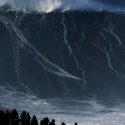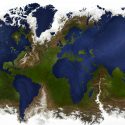Could you imagine jumping from the kitchen window and diving into water? How fun would that be? For some people, sure.
It seems unlikely, but it’s not as crazy as you might think. Scientists predict that by 2050, water levels in 570 coastal cities worldwide will rise by half a meter (1.6 ft), threatening 800 million people.
In some cities, the authorities have already responded by building coastal walls for protection. In other cities, they are discussing the possibility of making walls.
Which coastal cities are the most threatened? How would you build the walls? How long would these walls need to be?
The climate crisis is one of the biggest issues facing humanity. Ice sheets are melting due to Earth’s increasing temperature. Because of it, the sea level is rising 4.8 mm (0.19 in) per year. It seems such an insignificant number. So why are experts so concerned?
The problem is that ice melting and the thermal expansion of ocean water increase proportionally with temperature. The more the planet continues to warm up, the more the sea level will rise.
Climate scientists estimate that from 2040 to 2060, sea levels will rise 25 cm (9.8 in). This could cause 100-year floods on some coastlines, and they could become a near-annual occurrence
Now, imagine your daily routine with 25 cm (10 in) of water in your house, at work, and on the street. Water boots, anyone?
If all of our planet’s remaining small glaciers were to melt, the sea level would rise about 50 cm (19.7 in). So, what would happen if all of the ice sheets melt?
There are three major ice sheets on Earth. One is in Greenland, and the other two are in Antarctica, known as the West and the East Antarctic ice sheets. The Greenland and the West Antarctic ice sheets are melting and shrinking.
And if they melt entirely, the sea level would be 12 m (39 ft) higher than it is now. Much of our coastal cities would be submerged. So, you might want to save some money for a comfy houseboat because you would need one. Thankfully, the East Antarctic, the biggest of the three ice sheets, is among the most stable. It isn’t gaining or losing mass. Not yet.
If it did, though, the sea level would rise another 53 m (174 ft) for a total of 65 m (213 ft). That would submerge kilometers (miles) of coastal land, and entire cities would disappear.
Maybe we would build floating cities, and new generations of humans might develop bodies able to live under the water. Right.
Before that happens, let’s just say we want to build walls to protect our cities. How much would they cost?
Well, it wouldn’t be cheap, that’s for sure. The world’s coastlines are about 1.6 million km (994,193 mi) long. This is the same distance as going to the Moon and back twice.
An estimation that it would cost approximately $400 billion, just for the U.S. Still, it would be cheaper than the $14.2 trillion in lost or damaged assets projected to happen by the end of the century.
More than 287 million people could be exposed to episodic coastal flooding by 2100. To put it in prospect, Indonesia has a population of around 273 million people. You do the math.
Unfortunately, Indonesia is also one of the countries most threatened by rising sea levels along with the United States, northwestern Europe, and large parts of Asia such as the Bay of Bengal, China, and northern Australia. OK, so how could we make these walls?
Maybe we could use traditional materials, including rock or interlocking concrete units. Or we might build steel barriers like the Maeslantkering in the Netherlands
The huge machine consists of two large arms on each side of the waterway that can be deployed when needed to block it. What we should keep in mind is that these walls should work in balance with the ecosystem and disrupt it.
On this note, there are also nature-based solutions such as recreating dunes, human-made reefs, mangroves, or marshland that would work just fine, if not even better than the concrete walls. Unfortunately, nature-based solutions don’t seem to be the preferred option, at least right now. There are major plans all over the world to start building the walls instead.
Sources
- “A Terrifying Sea-Level Prediction Now Looks Far Less Likely”. Meyer, Robinson. 2019. The Atlantic.
- “As sea levels rise, are we ready to live behind giant walls?”. Hannah, Cloke. 2020. The Conversation.
- “EXPANSION OF WATER” 2021. sealevel.jpl.nasa.gov.
- “Coastal sea level anomalies and associated trends from Jason satellite altimetry over 2002–2018”. 2020. Scientific Data 7 (1). doi:10.1038/s41597-020-00694-w.
- “Seas are rising faster than ever”. Paul, Voosen. 2020. Science | AAAS.
- “Why Should We Worry About Sea Level Change?”. Martin J. Siegert 2021. Frontiers For Young Minds.



























